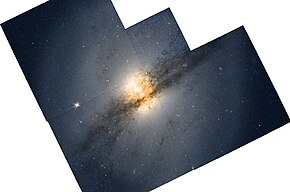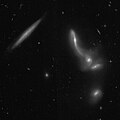| NGC 3718 | |
|---|---|
 NGC 3718 | |
| Observation data (J2000.0 epoch) | |
| Constellation | Ursa Major |
| Right ascension | 11h 32m 34.940s[1] |
| Declination | +53° 04′ 04.18″[1] |
| Redshift | 0.003306[2] |
| Distance | 47.84 ± 8.54 Mly (14.667 ± 2.618 Mpc)[3] |
| Apparent magnitude (V) | 10.61[2] |
| Characteristics | |
| Type | SB(s)a pec[3] |
| Apparent size (V) | 2.940″ × 2.352″[1] |
| Other designations | |
| Arp 214, UGC 6524, MCG+09-19-114, PGC 35616[2] | |
NGC 3718, also called Arp 214, is a galaxy located approximately 52 million light years from Earth in the constellation Ursa Major.[4][2][5] It is either a lenticular or spiral galaxy.[6]
NGC 3718 exhibits a warped, S-shape similar to NGC 6872, possibly a result of gravitational interaction with NGC 3729, another spiral galaxy located 150,000 light-years away.[7]
NGC 3718 is a member of the Ursa Major Cluster.[8]
Hickson Compact Group
[edit]South of NGC 3718 the Hickson Compact Group #56 is located. HCG 56 is a compact group of galaxies of which 4 members are interacting with each other. This group is about 120 Mpc distant to our galaxy,[9] which is about 8 times more distant than NGC 3718.
Gallery
[edit]-
NGC3718 and its companion NGC 3729.
-
NGC 3718 and HCG 56 with the legacy surveys
-
The Hickson Compact Group #56 with Hubble
References
[edit]- ^ a b c Skrutskie, Michael F.; Cutri, Roc M.; Stiening, Rae; Weinberg, Martin D.; Schneider, Stephen E.; Carpenter, John M.; Beichman, Charles A.; Capps, Richard W.; Chester, Thomas; Elias, Jonathan H.; Huchra, John P.; Liebert, James W.; Lonsdale, Carol J.; Monet, David G.; Price, Stephan; Seitzer, Patrick; Jarrett, Thomas H.; Kirkpatrick, J. Davy; Gizis, John E.; Howard, Elizabeth V.; Evans, Tracey E.; Fowler, John W.; Fullmer, Linda; Hurt, Robert L.; Light, Robert M.; Kopan, Eugene L.; Marsh, Kenneth A.; McCallon, Howard L.; Tam, Robert; Van Dyk, Schuyler D.; Wheelock, Sherry L. (1 February 2006). "The Two Micron All Sky Survey (2MASS)". The Astronomical Journal. 131 (2): 1163–1183. Bibcode:2006AJ....131.1163S. doi:10.1086/498708. ISSN 0004-6256. S2CID 18913331.
- ^ a b c d "NGC 3718". SIMBAD. Centre de données astronomiques de Strasbourg. Retrieved 8 December 2017.
- ^ a b "NED results for object NGC 3718". National Aeronautics and Space Administration / Infrared Processing and Analysis Center. Retrieved 8 December 2017.
- ^ Nemiroff, R.; Bonnell, J., eds. (31 August 2006). "Extra Galaxies". Astronomy Picture of the Day. NASA.
- ^ "Best of AOP: NGC 3718". noao.edu. Archived from the original on 2015-05-24. Retrieved 2015-01-26.
- ^ "NGC 3718, Spiral Galaxy". kopernik.org.
- ^ "APOD: 2013 August 3 - Twisting with NGC 3718".
- ^ Tully, R. Brent; Verheijen, Marc A. W.; Pierce, Michael J.; Huang, Jia-Sheng; Wainscoat, Richard J. (December 1996). "The Ursa Major Cluster of Galaxies.I.Cluster Definition and Photometric Data". The Astronomical Journal. 112: 2471. arXiv:astro-ph/9608124. Bibcode:1996AJ....112.2471T. doi:10.1086/118196. ISSN 0004-6256. S2CID 7875515.
- ^ "By Name | NASA/IPAC Extragalactic Database". ned.ipac.caltech.edu. Retrieved 2023-08-06.
External links
[edit] Media related to NGC 3718 at Wikimedia Commons
Media related to NGC 3718 at Wikimedia Commons



Well, that’s interesting to know that Psilotum nudum are known as whisk ferns. Psilotum nudum is the commoner species of the two. While the P. flaccidum is a rare species and is found in the tropical islands. Both the species are usually epiphytic in habit and grow upon tree ferns. These species may also be terrestrial and grow in humus or in the crevices of the rocks.
View the detailed Guide of Psilotum nudum: Detailed Study Of Psilotum Nudum (Whisk Fern), Classification, Anatomy, Reproduction